| ACER palmatum dissectum
'Red Feathers'
Essentially a variation on the infamous 'Red Filigree Lace' but I find this one to be a better garden plant even though the rich reddish purple leaves are every bit as feathered as its cousin. Nevertheless it remains slow growing (particularly when young) and notoriously difficult to propagate. See it in our Maple Glade. |
|
|
|
|
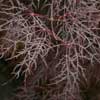 |
ACER palmatum dissectum
'Red Filigree Lace'
This may be a highly desirable dwarf, but it will never be widely available because it is difficult to propagate and so slow to grow away as a young plant. The deep leaves are lacier than in any other cultivar and the lovely deep purple colour is held until the autumn when it becomes bright red. Slow growing. |
|
|
|
 |
ACER palmatum dissectum
'Seiryû'
Unique amongst the dissectums for its upright growth and true tree-like habit - not to be confused with the mushroom types. It readily makes a vase-shaped small tree. Mid green leaves develop superb orange and red autumn colour, whilst the dissected leaves make for a very graceful tree. If so desired, as stature is attained with increasing maturity, so it can be "cloud pruned" to give a superb effect. 3-4m See it in our Maple Glade. |
|
|
|
|
ACER
palmatum dissectum 'Sekimori'
This pretty dissectum is characterised by a habit that is more prostrate and less arching than its rivals. The feathery light green leaves typically develop yellow autumn colour that can take on orange tones in some years. As a welcome bonus, the bark is also noteably attractive, with pronounced white striations. |
|
|
|
|
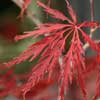 |
ACER
palmatum dissectum 'Shojo shidare'
Deep maroon foliage intensifies with maturity, suffused down the centre of each lobe with rich green. More slender cascading habit than many lends itself to caning up to gain instant height and structure for a truly dramatic effect. See it in our Maple Glade. |
|
|
|
|
ACER
palmatum dissectum 'Shû
shidare'
Another introduction from the Buchholz stable in the Flora Wonder(tm) Collection and I am indebted to Talon Buchholz for sharing his fabulous plants with us. He is certainly skilled in identifying a new cultivar that stands out as different from the huge number already named. This is a vigorous cultivar with a broad, mounding habit. The new growth is a coppery-orange as it unfurls, then, as it ripens it takes on a bicolor effect with copper margins highlighting the otherwise rich green leaves. The autumn colour is a vibrant orange-red, and this dominant orange colouring is embraced by the name which means "orange weeping" in Japanese. |
|
|
|
|
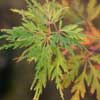 |
ACER
palmatum dissectum 'Spring Delight'
Further thanks to Talon Buchholz for this one; another of his own introductions that has become one of my favourites. It is gorgeous in spring when the new growth unfolds with subtle shades of pinkish red edging the green leaves. Vibrant orange autumn colour. A rewardingly vigorous and satisfactory plant of typical dissectum size and shape. See it in our Maple Glade. |
|
|
|
| ACER palmatum dissectum
'Stella Rossa'
This recent Italian introduction has brighter red young growth and lacier leaves than is typical amongst purple dissectums. Purple summer colour is retained well, and the vivid red autumn colours are arguably the brightest of the group. Less vigorous than most of the other purple dissectums, so conditions need to be closer to their ideal. 1m See it in our Maple Glade. |
|
|
|
|
| ACER palmatum dissectum
'Sunset' This dissectum has quite distinctive colouring. Although fundamentally green the young growth is flushed with sunset shades of orange. As with so many, the exact colour will be influenced by the light levels. Typical in shape, it is very tidy in habit since the leaves tend to all lie along the same plane, nor are they "over-dissected". Difficult to describe, but quite distinct. Compact and slow growing. |
|
|
|
|
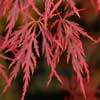 |
ACER palmatum dissectum
'Tamuke yama'
A Japanese cultivar dating back to 1911, but still strangely unknown in this country. Bright red young growth quickly turns purple, holding well all summer before turning bright red again in autumn. Cascading habit. |
|
|
|
| ACER
palmatum dissectum 'Toyama nishiki' Previously I've listed this as Acer palmatum dissectum 'Benishidare Tricolour' Numerous combinations of pink and cream colours develop from bright red young growth. Superb in a tub since it is particularly slow growing to 1.5m wide. Best in a rather shady place. |
|
|
|
|
| ACER
palmatum dissectum 'Van der Akker'
A more recent addition to our collection and an enigma at that. Trawling the 'net for more detail, I find that the respected Dutch specialist Firma Esveld list a plant under this name which is not a dissectum. However, that which is described by American nurseries tallies with mine. The red dissected leaves mature to green, giving a tone-tone effect by the end of the summer, rather dependant on light levels. The branches are horizontal more than weeping. |
|
|
|
|
| ACER
palmatum dissectum 'Vic Pink'
This is an Australian cultivar which has slightly coarser, "shaggier" foliage. Not sure who Vic is/was, but the pink manifests itself in a slight pinkish-bronze flush through the young leaves. Bright scarlet autumn colour is some of the best. |
|
|
|
|
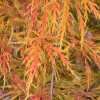 |
ACER palmatum dissectum
'Viridis'
This classic form of the green cut leaf Maple can eventually get rather large, but will take a great many years to do so! Wonderful yellow autumn colours often become bright red dependant on weather conditions. Equally effective in a pot, border, by the pond or as a specimen in the lawn. 1-2m The photo shows the early stages of autumn colour in a shady site. |
|
|
|
| ACER palmatum dissectum
'Waterfall'
Large, deeply divided bright green leaves and strongly cascading habit distinguish this hardy and beautiful cultivar. The leaves tolerate full sun quite well. Autumn colours are yellow, flushed with crimson. The original plant in New Jersey, USA is now over 70 years old and is 3m high by 4m wide. Within 10-15 years though, expect little more than the usual 1m. |
|
|
|
|
 |
ACER palmatum dissectum
'Watnong' A delightful selection with deeply divided leaves. The youngest growth is a bright pink, relatively quickly toning down to a bronzey green. This gives an ever changing range of subtle colours, the exact shades of which will be determined by the light levels. Not a vigorous grower, but seemingly fairly well behaved! See it in our Maple Glade. |